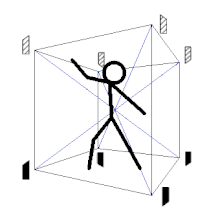Laban's Cube
I
Unit: Space and Relationship
Theme: Laban's Cube
Introduction
Dancers interact with space in myriad ways. They may stay in one place or they may travel from one place to another. They may alter the direction and level.
The use of space in a dance is considered the design of the movements and choreography, and also pertains to its location onstage.
Laban cube laban icosahedron. This very precise geometry is also the supporting structure for our personal interactions, defining personal space and body.
II
Learning Objectives
- Understand the meaning of the kinesphere within Laban's cube
- Explain how the design of movement within the cube influences your movement abilities and choice
- Gain an awareness of the possible locomotive advantages generated by the cube
- Experience movement language through a choreographed movement phrase
III
Main Lesson
1
Movement Exploration
Question 1
Write a reflection on your experience within the cube.
2
The kinesphere is also the container of a cube (containing all diagonal directions and dimensions) and of an icosahedron made by three bi-dimensional planes: it contains angular geometry inside a round geometry.
Question 2
Explain in your own words the meaning of the kinesphere within the Laban's cube?
IV
A Note to Remember
Laban's cube offers the dancer ta reference to connect his/her body to the space in a multi-dimentional manner.
V
Case Study
VI
Activity 1
Diversifying locomotive choices when using the performance space (The Kinesphere and Laban's Cube)
Practice
1. Based on your exploration of movement within the cube, work on creating a phrase of 8 movements.
2. Explore what is like to use that phrase to travel across the
diagonal.
To their previous 2 ensemble phrases, students add their new phrase.
Closing
Review & Share your phrases.
Students share their work with the class after adding to their choreographic structure (of two movement phrases) their new phrase.
VII
Journaling




Comments
Post a Comment